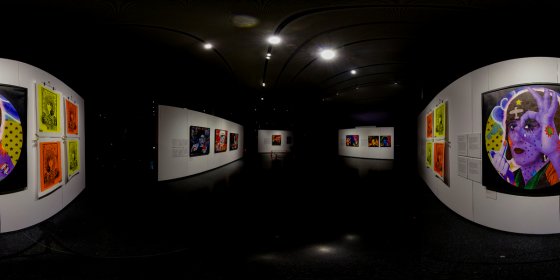VR 360° - Looking through Kiki's Eyes - Jonny Zerox

Bei dieser Ansicht, handelt es sich um eine barrierefreie Version,
hier geht es zur virtuellen interaktiven 360° Version der Tour 'Looking through Kiki's Eyes - Jonny Zerox'.
hier geht es zur virtuellen interaktiven 360° Version der Tour 'Looking through Kiki's Eyes - Jonny Zerox'.
verknüpfte Standpunkte
"Eve: Why Blame Me?""Inky Dream"
"Silent Protest"
"Crime Scene"
"Edie Sedgwick - Factory Girl"
"David Bowie - Changes"
"California Man - Happiness is a Warm Gun"
"Skeleton"
"The Future is Female"
4_Johnny_Zerox_stitched_P
enthaltene Informationen
"Kiki in the Sky with Diamonds" (DE) ⇒
Konsumkultur, Technologie und Feminismus waren wiederkehrende Themen in Kikis Werk, ebenso wie ihre Faszination für Raumfahrttechnologie und Robotik.
1962 zieht sie nach New York, wo sie sich am Broadway ein Studio mit Sam Francis teilt. Sie integriert sich rasch in die New Yorker Kunstszene an der Seite von Andy Warhol, Claes Oldenburg und Roy Lichtenstein, die Pop Art als Reaktion auf den abstrakten Expressionismus entwickeln. Kiki Kogelnik kreiert in dieser Zeit ihre Space-Art-Bilder und später ihre berühmten “Hangings“, eine Gruppe von Vinylskulpturen, die die Silhouetten von Körpern nachzeichnen. An Kleiderbügeln hängend zählen sie heute zu ihren wichtigsten und innovativsten Werken.
Kogelnik inszenierte die Marke “Kiki Kogelnik“ in schrill-selbstinszenierendem Stil mit Hilfe von Stilisierung und modischer Übertreibung. Der Künstler als Schatten seiner selbst, weit davon entfernt, mystische Kreativität zu feiern? Auf jeden Fall gehäutet und zur Schau gestellt. Eine spontane Erinnerung an die schwindende Bedeutung des Individuums in der Massengesellschaft.
1971 beginnt Kiki Kogelnik mit der Arbeit an der Serie ihrer “Women’s Liberation“ Bilder, die sich mit Werbeästhetik, Mode und Lifestyle auseinandersetzen. Die Depersonalisierung macht die Frauen zu “Vorbildern“, anstatt sie lediglich als Objekt der Begierde zu zeigen.
"Kiki in the Sky with Diamonds" (EN) ⇒
Consumer culture, technology and feminism were recurring themes throughout Kiki’s work as was her fascination for space travel technology and robotics.
In 1962, she moves to New York, where she shares a studio with Sam Francis on Broadway, assimilating herself into the New York art scene alongside Andy Warhol, Claes Oldenburg and Roy Lichtenstein, who are developing Pop Art as a reaction to abstract expressionism. During that period, Kiki Kogelnik creates her Space Art pictures and, subsequently, her famous “Hangings”, a group of vinyl sculptures tracing the silhouettes of bodies. Hanging from coat hangers, these sculptures are considered today to be among her most pivotal and innovative works.
Kogelnik staged the “Kiki Kogelnik” brand in her shrill-self-portrayal style with the help of stylization and fashionable exaggeration. The artist as a shadow of himself, far from celebrating mystical creativity? Definitely skinned and put on display. A spontaneous reminder of the dwindling importance of the individual in mass society.
In 1971, Kiki Kogelnik starts working on the series of her “Women’s Liberation” paintings, dealing with advertising aesthetics, fashion and lifestyle. The depersonalization of women makes them “role models”, rather than showing them only as an object of desire.